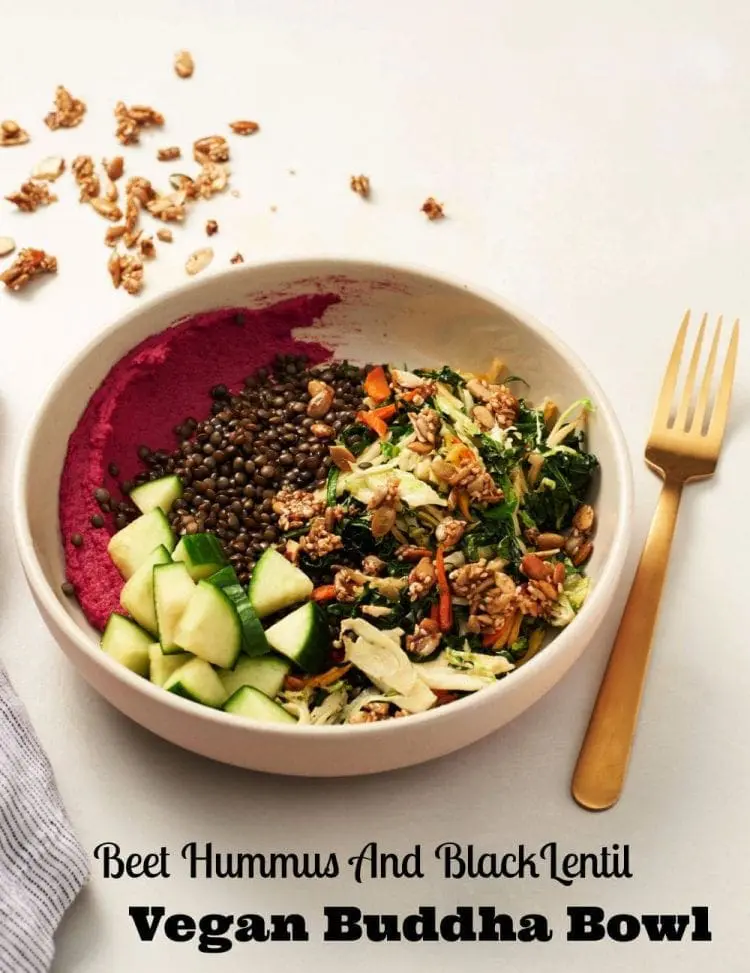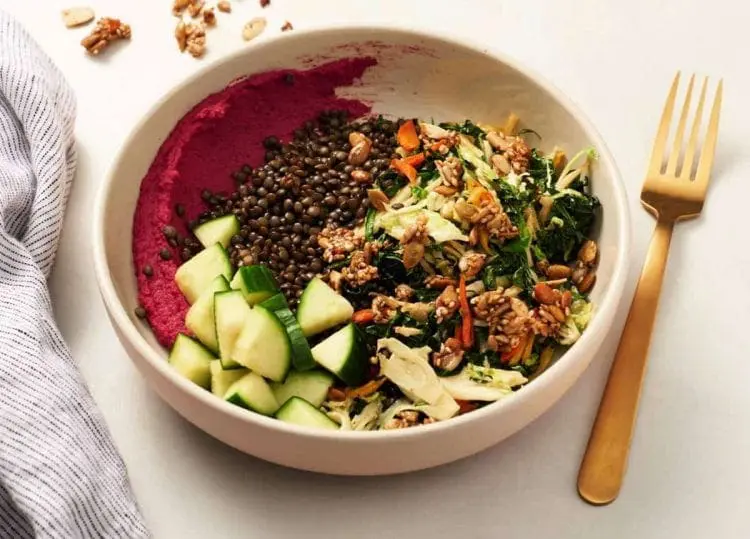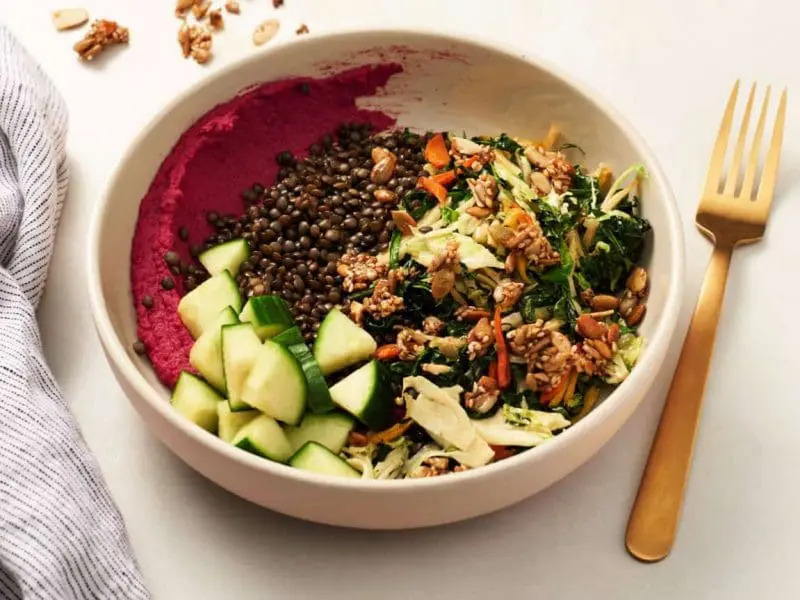Buddha bowls are a popular food trend because they are a beautiful, plant-based, comfort food served up in single dish- usually a large, shallow bowl. I am talking about a fully satisfying meal with lots of fixings. There is something about the arrangement and variety of the whole grains, proteins, and vegetables, drizzled with a sauce that just makes you feel like you are in for a real treat. And you are! Buddha bowls are all about packing in nutritious foods that offer big flavor for simple, wholesome meals that taste as good as they look. That is why I am so excited to be able to feature a beet hummus lentil vegan buddha bowl from the brand new cookbook Plant-Based Buddha Bowls by Kelli Foster, staff writer and editor for The Kitchn.
This cookbook is filled with robust buddha bowl recipes. They are perfect for both the dinner weekday whirl and for impressive weekend meals with family and friends. Plus, there are more than a dozen Morning Buddha Bowls for a power-packed start to the day; Buddha Bowls on the Go, perfect for packing for school or work; calming Mood Bowls, for light suppers and late-night snacks; and even Sweet Buddha Bowls, which use natural sugars only, for treats and desserts. These nourishing bowls feature a variety of delicious grains, from the familiar, like oats, barley, quinoa, and brown rice, to the newly popular, like amaranth, freekeh, and farro, along with all manner of whole grain noodles.

Meal Prep Buddha Bowl Recipes
My husband likes to call these hippie bowls. I say, if you mean they are packed with stuff that is good for, tastes good, and is good for the planet, then sure! A good vegan buddha bowl recipe like this one is a great way to have a healthy meal in just one power bowl. Be sure to make extras of the components and store them in airtight containers. This way you can use them to make your own creative, delicious vegan buddha bowl by just adding a new element. For example make the leftovers into a new grain bowl by adding wild rice or changing the protein source to black beans, crispy tofu, or crispy chickpeas. They are great options for a healthy lifestyle.
It was super tough choosing just one buddha bowls recipe to share with you here. After much deliberation, I chose this beet hummus lentil buddha bowl because of the lovely balance of fresh veggies with the hearty lentils and the creamy fresh hummus! Plus, the smattering of quick pickled fennel and the savory seed sprinkles just really makes this dish pop!
Buddha bowls are perfect for those of you that like to meal prep. Because Buddha bowls feature a number of different foods in each bowl, you can mix and match elements to get lots of different buddha bowls even when using many of the same ingredients. You can also use elements like buddha bowl dressing or seed sprinkles on multiple dishes.
Recipe For Beet Buddha Bowl Vegan

Roasted Beet Hummus Buddha Bowls
Plant-Based Buddha Bowls: 100 Recipes for Nourishing One-Bowl Vegan Meals
Kelli Foster
FRONTLIST | On Sale Date: April 6, 2021
ISBN: 9781592339501
Harvard Common Press
I know looks aren’t everything, but just look at this beet hummus. It’s a total stunner, and it has the most irresistible taste to match. Here, white beans are blended with earthy steamed beetroot. Make it a meal by rounding out your bowl with toothsome black lentils (if you can’t find them, French lentils make a nice substitute), sautéed shredded kale and Brussels sprouts, and crisp cucumber.
The hummus is smooth and creamy and has a great sauce texture to make the bowl even more scrumptious.
Buddha Bowl Ingredients List
With ingredients like beets, white beans, black beluga lentils, extra virgin olive oil, Tuscan kale, Persian cucumbers, and avocado, how can you go wrong? Delish!
Get a head start! The beetroot can be roasted, peeled, and chopped a day ahead and stored in the refrigerator. The beet hummus can be made a day in advance and stored in an airtight container in the refrigerator. The lentils can be cooked in advance and reheated, if desired, before serving.
Here are detailed instructions in this printable recipe card below for how to make a buddha bowl step by step.
Printable Lentil Buddha Bowl Recipe Card
Beet Hummus Lentil Buddha Bowl (Vegan)
Ingredients
- 1 medium red beet (about 6 ounces [168 g])
- 1 (15-ounce [420 g]) can white beans, drained and rinsed
- ¹⁄₃ cup (80 g) tahini
- Juice from 1 lemon
- 1 clove garlic
- ½ teaspoon fennel seed
- Kosher salt and freshly ground black pepper
- ¾ cup (140 g) black beluga lentils, rinsed
- 1½ tablespoons (23 ml) avocado or extra virgin olive oil
- 1 small bunch Tuscan kale, leaves thinly shredded
- 8 ounces (225 g) Brussels sprouts, trimmed and shredded
- ½ cup (55 g) shredded rainbow carrot
- 2 Persian cucumbers, chopped
- 1 medium fennel bulb, thinly sliced and pickled
- 2 tablespoons (16 g) Savory Seed Sprinkle
Instructions
- Preheat the oven to 400ºF (200ºC or gas mark 6).
- Wrap the beetroot in foil and roast until tender enough to be pierced through with a knife, 60 to 70 minutes. When cool enough to handle, use a paper towel to rub off the beet skin and discard. Remove the root and roughly chop the beet.
- Place the chopped beet, white beans, tahini, lemon juice, garlic, fennel seed, a pinch of salt, and a few grinds of black pepper in a food processor or blender. Process until smooth and creamy.
- Place the lentils and a pinch of salt in a medium saucepan and cover with water by at least 2 inches (5 cm). Bring to a boil over medium-high heat, then reduce the heat to low, cover, and simmer until tender, about 25 minutes. Drain the excess water.
- Meanwhile, heat the oil in a large skillet over medium heat until shimmering. Add the kale and Brussels sprouts and cook, tossing occasionally, until just wilted, about 3 minutes. Remove from the heat and stir in the carrot.
- To serve, divide the beet hummus among four bowls and spread over the bottom and up one side. Top with the lentils, kale mixture, cucumber, and pickled fennel and sprinkle with the Savory Seed Sprinkle. Serve with warm pita, if desired.
Nutrition Facts
Beet Hummus Lentil Buddha Bowl (Vegan)
Serves: 4
|
Amount Per Serving: 1 bowl
|
||
|---|---|---|
| Calories | 634.78 kcal | |
| % Daily Value* | ||
| Total Fat 38.75 g | 58.5% | |
| Saturated Fat 5.47 g | 25% | |
| Trans Fat 0.0 g | ||
| Cholesterol 0.0 mg | 0% | |
| Sodium 821.93 mg | 34.2% | |
| Total Carbohydrate 59.15 g | 19.7% | |
| Dietary Fiber 16.7 g | 64% | |
| Sugars 12.57 g | ||
| Protein 24.3 g | ||
| Vitamin A 39.83 % | Vitamin C 125.62 % | |
| Calcium 40.64 % | Iron 56.07 % | |
* Percent Daily Values are based on a 2,000 calorie diet. Your daily values may be higher or lower depending on your calorie needs.
Family Focus Blog
Serve with warm whole-grain pita (optional) and enjoy!
Buddha Bowl Ideas For Toppers
Quick-Pickled Vegetables
Quick-pickled vegetables just might be the ultimate bowl topper. They have a tangy acidity, often accompanied with at least a little bit of crunch, that livens up any other ingredients they’re partnered with. If you’ve never quick-pickled vegetables before, I assure you it’s easier than it might sound and doesn’t take a long time. You’ll want to stick with crisp, firm vegetables, like cabbage, radishes, fennel, carrots, onion, and cucumbers, which should be thinly sliced or shredded. Then it’s a matter of boiling equal parts vinegar and water, along with a pinch of salt. You’ll pour the hot liquid over the vegetables and let them soak. More time is always better to get more flavor, but as little as 10 minutes will get the job done. This basic recipe calls for distilled white vinegar, but you can also try using apple cider vinegar or rice vinegar to change it up.
1 Finely slice, shred, or grate the vegetable. Place in a medium to large heatproof bowl.
2 Place the vinegar, water, and salt in a small saucepan. Bring to a boil over medium-high heat, stirring regularly, until the salt is dissolved. Pour the liquid over the vegetables and set aside for at least 10 minutes and up to 1 hour. Drain and discard the liquid.
There will still be a little vinegar on the vegetables and this makes a yummy dressing.
Yield varies
- Up to 1 pound (455 g) fresh vegetables, such as red onion, red cabbage, radishes, fennel, cucumber, and/or carrots
- 1 cup (240 ml) distilled white vinegar
- 1 cup (240 ml) water
- ¼ teaspoon kosher salt
Note: Store in the refrigerator for up to 5 days.
Savory & Sweet Seed Sprinkles
My favorite way to round out any dish is with something crunchy. By far the hardest part of making these sweet and savory seed mixtures is letting them cool completely without pinching a few bites from the baking sheet. I like to shop the bulk bins for the ingredients, so as not to have too many leftovers.
SAVORY Makes 1 scant cup (145 g)
- 1 teaspoon extra virgin olive oil
- ¼ cup (35 g) raw pumpkin seeds
- ¼ cup (35 g) raw sunflower seeds
- 2 tablespoons (18 g) raw sesame seeds (regular, black, or a mix)
- ¼ cup (30 g) raw sliced almonds
- 1 tablespoon (8 g) any mix of fennel seed, cumin seed, and caraway seed
- ¼ teaspoon kosher salt
- ¼ teaspoon garlic powder
- 1 tablespoon (15 ml) pure maple syrup
1. Heat the oil in a large skillet over medium-low heat. Add the nuts and seeds, sprinkle with the salt and garlic powder, and cook, stirring regularly, until fragrant and lightly browned, 8 to 10 minutes. Remove from the heat and stir in the maple syrup.
2. Transfer to a parchment-lined baking sheet, spread in an even layer, and let cool completely.
Conclusion
A vegan Buddha bowl is a nutrient-packed, colorful, and versatile meal that offers a perfect balance of flavors and textures. It’s an easy way to enjoy a variety of fresh, plant-based ingredients like grains, vegetables, legumes, and healthy fats in one satisfying dish. Whether you’re seeking a wholesome meal that’s both delicious and visually appealing, or simply want to explore more vegan options, a Buddha bowl is a great choice that can be customized to suit your taste and dietary needs.
I hope you enjoy this recipe for a healthy vegan buddha bowl. These tasty toppers can be served on top of any buddha bowl. Be sure to check out Plant-Based Buddha Bowls: 100 Nourishing One-Bowl Vegan Meals for even more great buddha bowl ideas. I love how her buddha bowl recipes include super nutrient-rich veggies like sweet potatoes, spinach, chard, and kale. She also uses lots of great bold flavors and aromatics, like garlic, ginger, lime, tamarind, and lemongrass. Vegans will love all the protein-rich plant-based ingredients like tofu, tempeh, nuts and nut butters, chia, hemp, and chickpeas.
Each buddha bowl is a nutritionally complete meal in just one dish! They are a great idea to get plant proteins and healthy foods together in one bowl with a yummy peanut sauce or a simple dressing like soy sauce or lime juice. Will you make your own buddha bowl? Share a pic of your one-bowl meal on social media @familyfocusblog!
Related Posts:



Allyssa says
Thanks a lot for this super easy and tasty recipe. I made this lentil power bowl for the fam and they loved it!
Logan Lee says
I really love this buddha bowl recipe. I will be making it again. Thanks for sharing your delicious and healthy vegan recipe with me.
Cutting Edger says
The beet hummus in this Buddha bowl sounds incredible! It’s such a creative twist on a classic recipe. I’m excited to incorporate lentils for added protein and texture.
Pardip says
Hi Scarlet,
I really love Buddha Bowl recipes. Thanks for sharing this vegan dish.
Please keep sharing because I love to cook and eat the food you suggest. Thanks.
Rose says
This vegan bowl recipe looks delicious and thanks for sharing with us.
Kidzonia says
I’ve been looking for a new vegan recipe to try, and this was a hit! The beet hummus adds such a unique flavor. I’ll definitely be making this again.